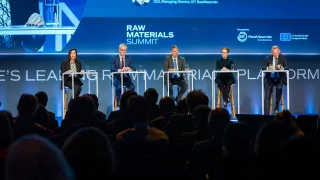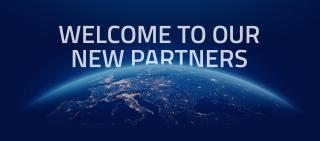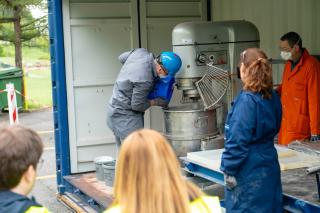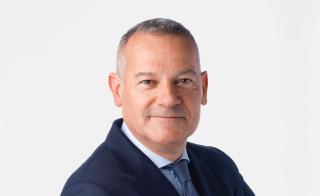Rebuilding Europe’s mining legacy: Laying the foundations for a responsible mining future
Rebuilding Europe’s mining legacy: Laying the foundations for a responsible mining future

EIT RawMaterials: How has Europe’s mining industry changed since you started out as a geologist? Can you highlight the most impressive innovations here?
Sinead Kaufman: When I graduated in the 1990s, Europe’s mining industry was a shadow of its former self. There was a rich mining history which had driven the European industrial revolutions of the 19th century but there were few mines still in operation. Mining knowledge and skills had been lost and the majority of raw materials were imported from elsewhere in the world. I consider myself to be an example of this shift. I was born in Ireland and studied geology in the UK, but my mining career has largely taken me outside Europe.
The significance of mining for Europe hasn’t changed though. Our modern lifestyles depend even more on the metals and minerals, such as steel, copper and aluminium, that can only be obtained from mining – these are the raw materials of products we take for granted, like cars, mobile phones, MRI and healthcare machines, batteries etc. What has changed is the way we mine. Modern mining is driven by technology and our increasing understanding and use of data means we can extract the minerals the world needs more safely, more efficiently, and with less impact on our environment.
Mining has a long history, but we’re not rooted in the past. The industry globally has evolved to meet modern demands, whether that’s producing low-carbon aluminium, operating all-electric mining trucks, or repurposing waste. While the mining footprint in Europe has changed, the geology has not, the raw materials needed for a modern society can be mined in Europe safely and sustainably.
EIT RawMaterials: What steps can the mining industry take to improve its legacy?
Mining can’t change the past; but the industry can work to find ways to partner much more closely with society to enhance our futures.
Sinead Kaufman,
I believe the industry needs to be radically transparent on environmental impacts, economic benefits, and decision-making processes. People need to be consulted, and communities must feel that their voices and concerns are being heard and being acted upon. We need to go out of our way to ensure that consultations on environmental impact assessments, and water use, are meaningful. They cannot be tick-box exercises, and we need to continually work with all stakeholders to address genuine concerns and ensure people are informed and feel comfortable with how we operate.
EIT RawMaterials: Can you give us some examples from Rio Tinto where ESG practices and community engagement have been successfully implemented? What key strategies helped secure community support for new mining projects?
Sinead Kaufman: At our Diavik diamond mine near the Arctic Circle in northwest Canada, we have an Aquatic Effects Monitoring programme that I’m particularly proud of. Diavik is surrounded by Lac de Gras, a pristine water resource, and a programme was designed by local community members to evaluate fish health and water quality using traditional indicators. Fish are caught, cleaned, inspected, cooked, and tasted. Water is inspected, sampled, boiled, and tasted. Participants share their traditional knowledge of the Lac de Gras area and record their observations of the fish and the water.

Wind farm at Diavik diamond mine. Photo: Rio Tinto
Another example is at Oyu Tolgoi, our copper mine in the Gobi Desert in Mongolia. Local community leaders told us that their two main priorities were access to better health services and facilities, as well as the need to protect and safeguard their cattle herding traditions. Over the past 15 years, we have worked to establish a community health programme and a herders’ livelihood support programme. The first has reduced the threat posed by infectious diseases amongst the local population and significantly improved access to quality medical care. The herders’ scheme has directly addressed water scarcity issues in the Gobi Desert, improved pastureland use and protection, as well as increasing the number of watering points and water supplies. We also work with two government programmes, to ensure access to vets to improve animal husbandry, and to support the creation of local cooperatives amongst the herders which increase their income from herding.

Concentrator, Oyu Tolgoi, Khanbogd, Mongolia. Photo: Rio Tinto
EIT RawMaterials: What are the key issues that Europe needs to address to attract significant investment to the European mining sector?
Sinead Kaufman: Europe urgently needs significant investment to achieve its sustainability ambitions and the mining industry, alongside its investors, needs certainty if they are to invest the billions needed in projects that can take decades to yield a return. Consequently, there needs to be a constructive, multi-stakeholder dialogue to build investor confidence as well as potential access to public finance, funds and subsidies in tandem with their investments.
In terms of a new policy framework, the EU’s Critical Raw Materials Act (CRMA) is a major step forward and a once-in-a-generation shift in attitude, but there is still a long way to go. We need Europe to drive harmonised rules and regulatory procedures as well as fast-track permitting, without compromising due process and still enforcing the highest standards.
However, even if Europe starts to extract more of its own domestic resources, the anticipated rise in demand means that it will need to continue to both import more and recycle much more of what it needs. For imports, this means Europe must avoid protectionism and keep its borders open. For recycling, there needs to be investment in the circular economy to get it to an economic scale.
EIT RawMaterials: The Jadar Project in Serbia recently had its spatial plan reinstated by the Serbian government. What does this mean for the broader European EV value chain, and advancing European mining projects?
Sinead Kaufman: It sets a precedent and marks a major milestone for Europe by being the first major new initiative to secure licenses since the CRMA was adopted in May. It also represents a move away from the new policy framework towards implementation and operations. Downstream industries, such as the automotive and energy sectors, have a vested interest in securing their supplies of responsibly sourced lithium to ensure Europe’s decarbonisation objectives and their future competitiveness. We still have a long way to go; the regulatory process is still underway but by working closely with our stakeholders we can mitigate challenges and concerns. Jadar has the potential to become a major catalyst for new investment and set a new standard for responsible mining.
Jadar is a good example of a new greenfield project that can produce enough lithium to make one million electric vehicles each year, built and operated using modern mining methods utilising the latest technologies to produce a critical material to the highest of environmental standards.
Sinead Kaufman, as the Chief Executive of Rio Tinto’s Minerals product group, oversees operations across three continents. This interview followed up on points she raised during her participation as a panel speaker at the “Critical Raw Materials Act – Policy Meets Industry” session during this year’s Raw Materials Summit. The next summit is scheduled for May 13-15, 2025. eitrmsummit.com


